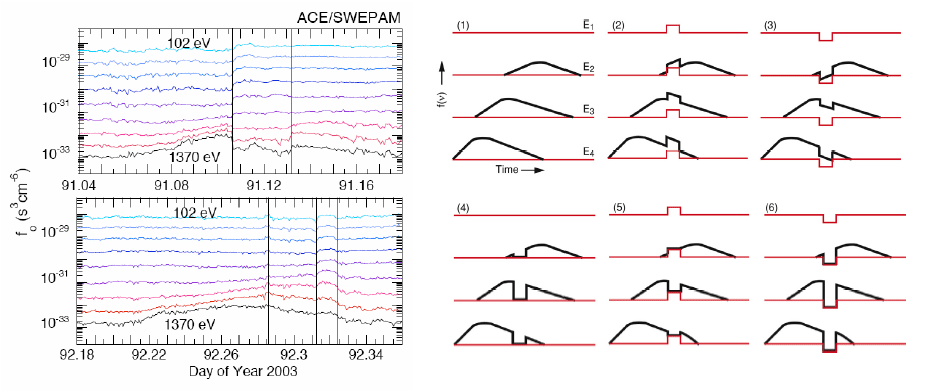
| ACE News Archives | ACE News #78 - January 29, 2004 |
Subscribe to ACE News |

Discontinuous changes in the solar wind electron strahl intensity commonly occur at boundaries such as the heliospheric current sheet that separate flows originating from distinctly different coronal regions. Discontinuous, dispersionless changes in strahl intensity observed elsewhere in the wind probably also arise from sudden changes in magnetic connection to the corona. In the latter case the connection changes may arise from field-line foot-point motions during the 2-4 days it takes the solar wind and the embedded heliospheric magnetic field to travel out to 1 AU. Such motions cause field lines adjacent to one another at 1 AU to become spatially separated in the corona. Large, dispersionless modulations in intensity also occur within some solar electron bursts observed at energies <1.4 keV by ACE/SWEPAM. As illustrated in the left figure above (times indicated by vertical lines), these burst modulations commonly occur in conjunction with discontinuous changes in the underlying strahl intensity at lower energies.
A simple conceptual model invoking a spatially-limited burst source-region and field-line foot-point motions can largely explain these coupled modulations in burst and strahl intensity. The right figure above illustrates schematically the types of variations expected during a solar electron burst when a spacecraft momentarily connects to a distinctly different coronal region. In constructing the sketches it has been assumed that the temporary connection lies either within the burst source region (the top row of sketches) or entirely outside it (the bottom row of sketches). The different columns of sketches illustrate the types of variations that would be observed during temporary magnetic connections to regions where the strahl intensity is unchanged, increases, or decreases, respectively. The figure assumes that the strahl and burst intensities are simply additive, i.e., that the strahl and burst electrons exist independent of one another on the same field lines.
The set of red lines in each example show the assumed temporal variation of the strahl intensity at four different energies (E1 - E4), with the highest energy (E4) at the bottom. In the case illustrated the solar electron burst is confined to the 3 highest energies (E2 - E4) and, in the absence of foot point motions, would produce the dispersed temporal profiles indicated by the black lines in example 1. That example also illustrates the case of temporary magnetic connection to a different point in the burst source region where the emitted strahl intensity is unchanged. This simple model predicts correlated burst/strahl intensity modulations at all energies in examples 2, 3 and 6, anti-correlated modulations at the highest and lowest energies in example 5 (with intensity decreasing at the highest energies and increasing at the lowest energies), and decreases in intensity only at burst energies in example 4. Examples of all of these generic types of modulations are present in the SWEPAM observations. A further prediction that is consistent with the observations is that correlated burst/strahl intensity modulations should be more common than anti-correlated modulations, with correlated intensity depressions being more common than correlated intensity enhancements.
Submitted by Jack Gosling, Curt de Koning, Ruth Skoug, and John Steinberg of Los Alamos National Laboratory, and Dave McComas of Southwest Research Institute.
Last modified 29 Jan 2004, by